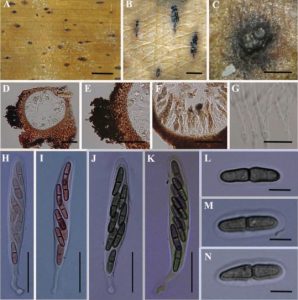Dianesea palmae (F. Stevens) Inácio & P.F. Cannon, Fungal Divers 9: 72 (2002), Index Fungorum number: IF 374776
≡ Cocconia palmae F. Stevens, Illinois Biol. Monogr. 11(2): 175 (1927)
Habitat on unidentified palm. Hemibiotrophic as small leaf spots 4.5 mm long × 2 mm wide, scattered, rarely confluent, amphigenous, as small, ± flat, black, stromatic structures, variable in shape, mostly elliptical, but sometimes circular or irregular, within dark brown to greyish leaf spots, dark brown intracellular hyphae penetrate the plant tissues. Sexual morph: Ascostromata 300–232 µm high × 315–258 µm diam., solitary, wall dark brown to black, superficial, globose to subglobose, with single locule, smooth, coriaceous, ostiolate. Ostiole usually widely porate, broadly papillate. Peridium 46–52 µm, comprising several layers of thick-walled, cells of textura angularis. Hamathecium of numerous, 2–3 µm diam., long, septate, cellular pseudoparaphyses. Asci 90–120 × 18–29 µm (x̄ = 112 × 25 µm), 8-spored, bitunicate, clavate to subcylindrical, with a short, narrow pedicel, thickened and rounded at the apex, with an ocular chamber. Ascospores 21–26 × 5–6 µm (x̄ = 23 × 5 µm), uniseriate to partially overlapping, hyaline to pale olivaceous when immature, dark brown when mature, ellipsoid or cylindrical to clavate, 1-septate, distinctly constricted at the septum, smooth-walled, thick-walled, surrounded by hyaline mucous sheath. Asexual morph: Undetermined.
Material examined: COSTA RICA. Peralta: on unidentified palm, 13 July 1923, F.L. Stevens 432 (K, isotype).
Notes: Genera within the family Phaeosphaeriaceae have thin-walled ascomata that are occasionally aggregated into multi-locular stromata, but are saprobes or necrotrophs and have quite distinct asexual morphs (Imicio & Cannon 2002, Phookamsak et al. 2014); hence Dianesea could not be placed in this family. In this study, we suggest that Dianesea is morphologically similar to Metameris (family Botryosphaeriacae), except spore morphology especially the narrow ascospores with hyaline mucous sheath (Phookamsak et al. 2014). Therefore, the genus might be better accommodated in Botryosphaeriales regarding the similar characters to Metameris. However, we retain this genus in Dothideomycetes, genera incertae sedis until morphology coupled with molecular data can resolve the correct placement of this unusual genus.
Fig. 4. Cocconia palmae (lectotype). A, B Appearance of ascostromata on host substrate. C Close up of ascostroma. D Section of ascostroma. E, F Peridium. G Pseudoparaphyses. H–K Asci with short, broad pedicel, containing 8 ascospores. L–N Ascospores. Scale bars: A=500 µm, B–E=100 µm, G=10 µm, H–K=20 µm, I=5 µm, L–N=15 µm.

